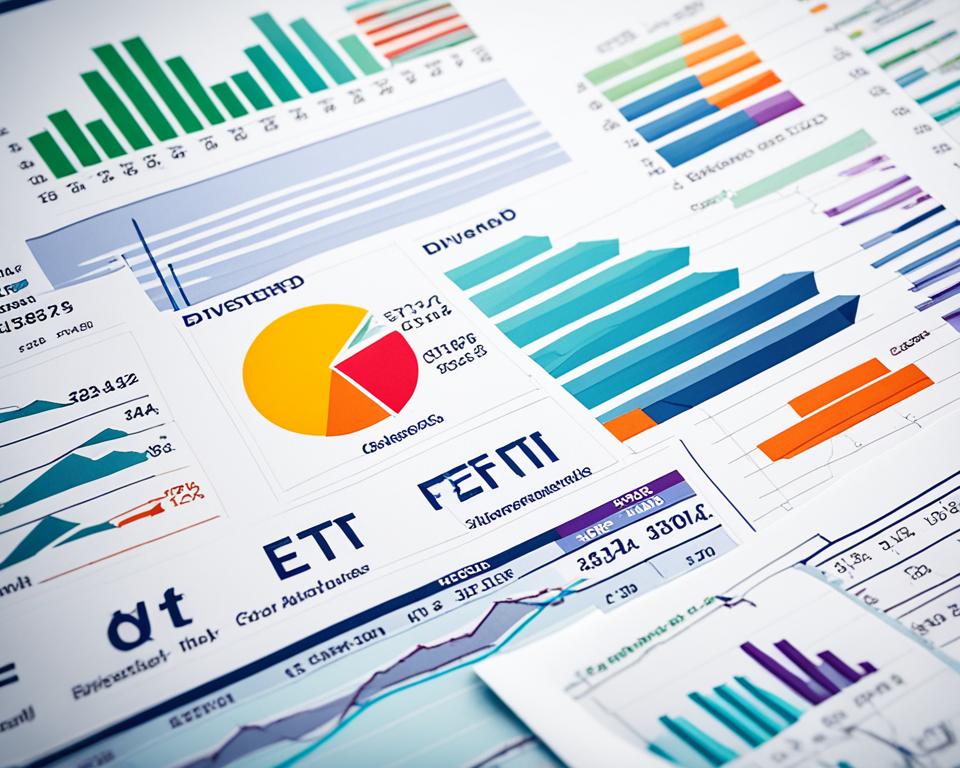As you embark on the journey of diversifying your dividend stock portfolio, a critical question looms: What is the optimal number of dividend stocks to maximize your returns without stretching your investments too thin? The world of finance often talks about the beauty of diversification as a means to reduce risk, but it’s not just about spreading your investments across multiple assets—it’s about wise choices that align with your financial objectives.
While some investors may reason that investment size dictates portfolio diversity, advancements in financial tools have shifted the landscape, allowing you to diversify successfully, regardless of the capital at your disposal. Whether you are managing a thousand dollars or a hundred thousand, the principles of diversification remain the same, and the secret to maximizing dividend stock returns lies in understanding both your personal risk tolerance and the nuances of the market.
Key Takeaways
- Identifying the optimal number of dividend stocks is crucial for risk management and portfolio growth.
- Diversification transcends portfolio size thanks to the accessibility of fractional shares.
- The focus on quality and strategic allocation can outweigh the sheer number of stocks held.
- Market expertise and individual risk appetite play pivotal roles in portfolio diversification.
- Adapting your portfolio strategically can lead to the maximization of your dividend stock returns.
The Significance of Portfolio Size in Dividend Investing
When embarking on the endeavor of building a dividend stock portfolio, the conventional wisdom may suggest that greater capital enables more extensive diversification. This provides the bedrock for prudent investment strategies like dividend stocks allocation. But has modern finance disrupted this longstanding belief? Let’s explore the transformative power of fractional shares and their impact on portfolio diversification with dividend stocks.
Understanding the Role of Portfolio Size Regardless of Investment Amount
It’s a common fallacy that one must possess a hefty investment capital to carve out a significant and varied portfolio. You might wonder if having $100,000 allows you to navigate the markets with greater ease than having only $1,000. However, the democratization of the stock market via fractional shares has leveled the playing field, ensuring that investors can expand their horizons, making them privy to a range of dividend-yielding enterprises, in spite of having modest sums to invest.
The Myth of Portfolio Size and Actual Diversification with Fractional Shares
Thanks to leading brokerage firms, the investment landscape has undergone profound changes with the advent of fractional shares. This innovative approach allows you to own slices of stock from high-value companies without the need for large amounts of capital upfront. It’s a powerful tool for building a dividend stock portfolio that’s diverse and robust in the face of market volatility. With these financial instruments, it’s not about how much you invest but how you allocate your resources in alignment with your personal goals and risk tolerance.
Investment experts advocate for strategic dividend stocks allocation to harness the benefits of diversification. To make informed decisions, understanding the transformative possibilities afforded by fractional shares is crucial:
- Accessibility: Fractional shares open the door to expensive, high-quality stocks, making them accessible to investors with limited funds.
- Flexibility: You can tailor your investment strategy to mirror a more varied market without the need for sizable individual stock purchases.
- Diversification: By owning a piece of multiple companies across various industries, you reduce the risk associated with single-stock investments.
Ultimately, wise allocation—a tenet of portfolio diversification with dividend stocks—transcends the quantity of your investment capital. It’s about the strategic composition of your portfolio, bringing together a blend of securities that reflects your financial objectives and risk profile, and unlocking the potential for a stable, growth-oriented income stream.
How Many Dividend Stocks Should I Own?
Deciding on how many dividend stocks should I own is essential to tailoring your investment portfolio to your unique financial goals. The general consensus among financial experts points toward holding a range of 20 to 30 dividend stocks for substantial diversification. This strategic number aids in balancing dividend stock holdings, mitigating risk while still offering a chance at significant investment growth.
Finding your footing between the two extremes of overexposure and overconcentration is imperative. With too few stocks, your portfolio risks being overly susceptible to market volatility. Conversely, too many can dilute potential returns and complicate ongoing portfolio management. Bearing this in mind, it’s not just a random assortment of stocks that you need, but a carefully curated collection that aligns with your investment strategy and appetite for risk.
- The magic range of 20 to 30 stocks strikes a balance, offering both risk reduction and potential for reward.
- Diversification doesn’t only mean more stocks but the right mix of stocks adeptly chosen.
- Each stock within your collection will variably impact the overall health of your investment portfolio.
- Finding the sweet spot in the number of stocks you own will help in effectively balancing potential gains with manageable risk levels.
As you craft your investment portfolio, prioritize creating a balance that speaks to your personal financial vision. Think about your long-term goals and the level of engagement you wish to maintain. Would you prefer to keep a closer eye on a smaller collection of companies, or are you comfortable managing a more extensive assemblage? Weighing these considerations alongside your risk tolerance will help guide you to the number of dividend stocks that is just right for you.
The Power of Diversification in Dividend Portfolios
Embracing the variety of the stock market, diversifying your dividend stock portfolio is a crucial step towards ensuring a resilient financial future. It’s not merely about owning a large number of stocks—it’s about selecting the right mix that can mitigate risks while positioning you for growth. Here, we delve into how a diverse portfolio forms a robust foundation for your investment strategy.
Minimizing Risks with a Diverse Dividend Stock Portfolio
As you contemplate the number of dividend stocks for growth, consider the resilience a multifaceted portfolio provides. By diversifying, you’re not just spreading your capital, you’re building a shield against market downturns and unforeseen sector disruptions. But it’s not a one-size-fits-all; the diversification must align with your unique investment needs and market insights.
The Impact of Diversification on Portfolio Volatility
Market volatility can be unsettling, making balancing dividend stock holdings a vital strategy. With a diversified set of dividend stocks, you’re not putting all your eggs in one basket. Instead, you create a buffer that absorbs market shocks, ensuring that a dip in one area of the market doesn’t spell disaster for your entire portfolio. The strategic combination of various stocks can smooth out the unpredictable waves of the market.
Choosing the Right Dividend Stocks for Effective Diversification
Effective diversification is not just the act of selection but the art of choosing. It’s the careful curation of stocks from different sectors, of varied cap sizes, and with distinct growth potentials. Your recipe for success involves mixing robust dividend-paying stocks with promising growth stocks, seasoned with the right proportion of large-cap, mid-cap, and small-cap offerings.
| Stock Type | Sector | Reason for Inclusion |
|---|---|---|
| Dividend-Paying | Consumer Goods | Stable cash flow and consistency in payouts. |
| Growth | Technology | Potential for significant price appreciation. |
| Large-Cap | Financials | Lower volatility and solid market presence. |
| Mid-Cap | Health Care | Balance between stability and growth potential. |
| Small-Cap | Energy | Higher risk but with the potential for high returns. |
Investing in Different Stock Types and Industries
The pursuit of building a dividend stock portfolio often brings one face-to-face with a crossroad: the choice between growth stocks that offer the potential for price appreciation and dividend payers that provide a steady income flow. A smart strategy for portfolio diversification with dividend stocks involves blending these two elements in a way that fits your financial landscape. The decision isn’t just about the potential for earnings; it’s also essential to consider how these investments play into your broader portfolio strategy. In essence, it’s not just what you hold, but also how these holdings complement each other in pursuit of diversifying your dividend stock portfolio.
Navigating Between Growth Stocks and Dividend Payers
As part of building a dividend stock portfolio, including both growth stocks and dividend payers can be a critical step. Growth stocks can be the sail that catches the market’s upward momentum, creating opportunities for significant capital appreciation. On the flip side, dividend payers are akin to the sturdy keel that offers stability and consistency, providing a buffer against market turbulence with their regular payouts. Striking the right balance depends on your financial objectives, level of risk tolerance, and the phases in your investment journey.
Why Industry Diversification Matters
Another essential facet of portfolio diversification with dividend stocks involves spreading your investments across various industries. This method is akin to planting a garden with a variety of crops, ensuring you have a harvest regardless of individual crop failures. Each industry rides its own unique wave of supply and demand, influenced by economic shifts, consumer trends, and technological advancements. By exposing your portfolio to this diverse economic landscape, you help protect against the volatility inherent in any single industry.
- Consumer Staples: Reliability even in economic downturns.
- Healthcare: A sector often resilient to economic cycles and reflecting a growing global demand.
- Technology: Offers growth potential and innovation edge, albeit with higher volatility.
- Utilities: Known for stability and consistent dividends.
- Energy: Can benefit from rising commodity prices, with some companies offering substantial dividends.
The craft of building a dividend stock portfolio is as much an art as it is a science, requiring you to blend the logic of market analysis with the creativity of strategic financial planning. As you weave together various stock types and industry sectors into your investment tapestry, remember that the choices you make today will shape the silhouette of your financial future. Aim for a portfolio that not only reaches for the stars with growth stocks but also brings you back to solid ground with stable dividend payers.
Maximizing Your Dividend Portfolio’s Performance Through Balance
To achieve the goal of maximizing dividend stock returns, it’s essential to maintain a finely-tuned balance within your investment portfolio. While the diversity of your holdings is a fundamental aspect of risk management, the process of balancing dividend stock holdings will often dictate your portfolio’s overall performance equilibrium. Let’s delve into the strategies that savvy investors employ to keep their portfolios performing optimally over time.
One of the critical aspects of balancing is ensuring that no single asset unduly influences the overall returns of your portfolio. This is where the process of regular rebalancing comes into play, serving as a mechanism to capitalize on the gains from high-performing stocks while also identifying and bolstering potential growth opportunities among undervalued assets. By periodically reassessing and adjusting your portfolio, you craft a landscape that is conducive to growth and mitigates risk through diversification.
- Regular Portfolio Review: Commit to a schedule of consistent portfolio reviews, be it monthly or quarterly, to assess the performance of your holdings against current market conditions.
- Profit Taking: Rebalance by selling a portion of your outperforming stocks to capture gains and reduce overexposure.
- Opportunistic Buying: Redirect the proceeds from your sales into stocks that appear undervalued, enhancing the potential upside of your portfolio.
The act of rebalancing involves a disciplined approach to investment management and requires a solid understanding of both the market and your individual financial goals. By taking a proactive stance on portfolio alignment, you ensure you’re balancing dividend stock holdings not only on your current expectations but also setting the stage for future success.
Remember, the essence of a balanced portfolio is its ability to respond and adapt to changing economic tides without capsizing. Your foresight in rebalancing is a testament to your commitment to maximizing dividend stock returns.
Conclusively, embracing a strategy focused on balance and regular refinement of your asset allocation is key to fostering resilient investment returns. As you consider your next move in the investment game, bear in mind that it’s not how many stocks you own that’s important. It’s the quality of your choices and their strategic distribution that will truly accelerate your journey towards a prosperous financial horizon.
Strategies for Rebalancing Your Dividend Holdings
As you journey through the complexities of building a dividend stock portfolio, you’ll discover that rebalancing is not merely a recommendation but a staple of maintaining balancing dividend stock holdings. A well-rounded rebalancing strategy is fundamental to your portfolio’s health and longevity, ensuring that your investments persistently align with your risk tolerance and financial goals.
Rebalancing is the periodic realignment of the weights of stocks in your portfolio. It is a disciplined approach that involves selling high to capture gains and buying low to exploit growth opportunities. By doing so, you stay true to your original investment strategy and avoid overexposure in certain sectors or stocks, thereby reinforcing the resilience of your portfolio against market fluctuations.
Annual vs. Quarterly Rebalancing: Pros and Cons
When considering rebalancing frequencies, you have a few options. The choice between annual and quarterly rebalancing carries its particular advantages and considerations:
- Annual Rebalancing
- Pros: Requires less time and attention throughout the year, potentially lower transaction costs due to infrequent trades.
- Cons: Higher volatility risk as portfolio drifts farther from target allocations between rebalancing.
- Quarterly Rebalancing
- Pros: More responsive to market changes, can take advantage of different market cycles throughout the year.
- Cons: Potential for higher transaction costs, requires more active management.
Deciding which strategy best fits your needs involves weighing these pros and cons against your individual investment style, the specifics of your portfolio, and your capacity for managing these activities effectively.
Understanding When to Rebalance Based on Portfolio Allocations
Another pivotal element in the rebalancing conundrum is determining when to act based on the composition of your portfolio. Here are guidelines you might consider:
- Percentage Thresholds: Implementing a rule where you rebalance if an asset class becomes a certain percentage more or less than its target allocation.
- Bands or Ranges: Allowing for a set fluctuation range and only rebalancing when assets fall outside of those predetermined bands.
- Significant Life Events: Using major changes in your personal life as triggers to reassess and realign your investments.
Whether you opt for a more scheduled approach or a more dynamic one, understanding your portfolio’s attribution and staying informed about market shifts are essential. Your tactics in balancing dividend stock holdings should reflect an awareness of market trends and an alignment with your individual investment journey.
Ultimately, the goal of rebalancing is to control risk and to ensure that your portfolio stays aligned with your investment objectives.
By adhering to these rebalancing strategies, you are not just passively watching over your investments but actively balancing dividend stock holdings to match your long-term vision. Whether adjusting annually or more frequently, these rebalancing acts are the quiet guardians of your investment horizon, dutifully maintaining the equilibrium essential for the endurance of your dividend stock portfolio.
Exploring Alternatives: ETFs and Alternative Investments
In the realm of investment, one often seeks ways to enhance the art of diversifying a dividend stock portfolio. While individual stocks can offer targeted growth opportunities, there are compelling alternatives that simplify the diversification process while potentially maximizing dividend stock returns.
Leverage the world of Exchange-Traded Funds (ETFs) to achieve a broader market exposure with ease. Alongside, explore the dynamic world of alternative investments through vehicles like Yieldstreet, which offers a different spectrum of asset classes. These can be integral components when pondering portfolio diversification with dividend stocks.
The Advantages of Exchange-Traded Funds for Diversification
Exchange-Traded Funds (ETFs) stand out as powerful tools for investors aiming to broaden their portfolio’s footprint. ETFs can ease the complexity of managing a multitude of stocks, by pooling various assets under one umbrella. Here are key reasons to consider ETFs:
- Diversification: ETFs encapsulate a range of securities, from equities to commodities, in one transaction—streamlining portfolio diversification.
- Accessibility: These funds can offer access to diverse markets or indices that might otherwise require significant capital and research to enter.
- Liquidity: With ETFs being traded like stocks on exchanges, you can buy and sell with ease, offering flexibility that can bolster your strategy for maximizing dividend stock returns.
Alternative Investments: How They Can Complement Dividend Stocks
When constructing a well-diversified portfolio, considering alternative investments becomes crucial. Platforms like Yieldstreet present unique opportunities that traditional stocks and bonds may not offer. These can enrich your approach to portfolio diversification with dividend stocks and provide a hedge against market volatility.
| Investment Type | Potential Benefits | Role in Diversification |
|---|---|---|
| Real Estate | Non-correlated asset with potential income through rents or property appreciation. | Adds a tangible asset with a different risk-return profile to the dividend stock mix. |
| Peer-to-Peer Lending | Possibility of higher yields compared to traditional bonds. | Provides income-generating assets that behave differently from stocks and bonds. |
| Art and Collectibles | Offers potential for appreciation independent of stock market performance. | Serves as a luxury alternative that can hold value or grow irrespective of market dips. |
With these innovative financial instruments, the goal is not just spreading your assets but creating a resilient and growth-oriented financial architecture. Incorporating ETFs alongside alternative investments like those found on Yieldstreet could well be your next strategic leap towards maximizing dividend stock returns.
Assessing Your Investment Horizon: Adjusting Dividend Stocks for Age and Risk Tolerance
When it comes to your dividend stocks allocation, considering your stage in life and risk tolerance is crucial. As an investor, your approach to the optimal number of dividend stocks will fluctuate not only with market conditions but also with personal circumstances, such as your age and how much risk you’re willing to take on. Young investors might sprint towards growth with a lean and concentrated portfolio of dividend stocks, while those nearing retirement might prefer a steadier pace with a broader mix. Understanding this dynamic can guide you in making informed decisions that align with your investment horizon.
Adjust your sails of dividend stocks allocation as you navigate through the changing tides of your life’s stages.
The allocation of dividend stocks in your portfolio is not a static strategy, but one that should evolve with time. In your younger years, there’s ample opportunity to recover from potential market dips, which can make a more aggressive strategy—centering on a smaller, more concentrated group of dividend stocks—appealing for potential higher growth rates. On the flip side, those in the latter stages of their investment journey may prioritize capital preservation, leaning toward a more defensive strategy with a higher number of dividend stocks to spread risk across various sectors and companies.
Here’s a breakdown of typical strategies based on investment horizons:
| Age Group | Risk Tolerance | Preferred Number of Dividend Stocks | Strategy Focus |
|---|---|---|---|
| 20s-30s | High | 10-20 | Growth and Capital Appreciation |
| 40s-50s | Moderate | 20-40 | Balance of Growth and Income |
| 60+ | Low | 40+ | Income and Capital Preservation |
Your individual risk tolerance also plays a critical role in determining your dividend stocks portfolio size. An aggressive investor might be comfortable with the uncertainty that comes with a high-growth, concentrated approach, while a conservative investor might prefer the relative safety of holding a wider array of dividend stocks. The optimal number of dividend stocks for you should provide a comfortable balance between peace of mind and potential returns.
- If your palms sweat at the thought of market shifts, consider a wider selection of dividend stocks to cushion against volatility.
- On the contrary, if you find excitement in the ebb and flow of the market, a more focused selection of dividend stocks might suit your bolder strategy.
- Remember, while aiming for the optimal number of stocks, ensure each investment decision is backed by thorough research and due diligence.
Adapting your portfolio strategy to the respective stages of your life allows you to maximize your financial well-being without exposing yourself to undue stress. Dividend stocks allocation is not just about quantity but aligning your financial goals with the appropriate level of risk at every age. Make adjustments as your circumstances change, and keep your eyes on the long-term horizon as you glide through the years.
Embrace change. The most successful investors adapt their dividend stocks allocation as their lives and markets evolve.
Understanding Over-Diversification vs. Under-Diversification in Dividend Portfolios
Embarking on the journey of tailoring a dividend-focused investment strategy, you might encounter the essential task of balancing dividend stock holdings. Here, it’s crucial to comprehend the notion that while broader diversification is protective, excessive dispersion can in fact stifle your portfolio’s vibrancy. Similarly, a scant selection amplifies the stakes and hazards. Navigating these extremes with finesse is imperative in formulating a robust portfolio.
Recognizing the Downsides of Over-Diversification
The premise of over-diversification often conjures a picture of cautiousness translating into a flurry of stock picks. However, when you hold more than the ideal number of dividend stocks for growth, your ability to monitor performance may falter, and the sharpness of returns may wane. Each additional stock beyond the balanced range incrementally shifts your portfolio towards an index-like composition, which can dilute the impact of individual stock gains on your overall portfolio performance.
Identifying the Risks of Holding Too Few Dividend Stocks
Conversely, an under-diversified portfolio brings about its own set of challenges. Should a handful of bets sour, your financial stability could be buffeted. In the spectrum of portfolio construction, wielding too few stocks sways towards speculation, leaving your investments susceptible to market adversity. Seeking the sweet spot—a well-calibrated mix that typically ranges from the strategic holding of 25 to 30 stocks—provides a buffer against this risk, allowing for deserved growth while mitigating against crippling downturns.
In conclusion, as you navigate the waters of income-focused investing, remember that the art of balancing dividend stock holdings resides in a clear understanding of the risks and returns at play. Deliberately constructing your portfolio with the number of dividend stocks for growth that’s just right for you, while avoiding over- or under-diversification, is the masterstroke to sustaining and augmenting your dividends-driven aspirations.
FAQ
What is the optimal number of dividend stocks for portfolio diversification?
Financial experts generally recommend holding between 20 to 30 stocks to achieve meaningful diversification in a dividend stock portfolio. This range helps to balance exposure and concentrated investing for diversified returns.
How does portfolio size affect dividend investing irrespective of the investment amount?
The significance of portfolio size in dividend investing is less about the amount of money invested and more about achieving diversification. With the availability of fractional shares, even investors with limited capital can own a diversified portfolio similar to those with larger investments.
Can you have too many dividend stocks in your portfolio?
Yes, it’s possible to have too many dividend stocks, a situation known as over-diversification which can lead to diluted returns and complicate portfolio management. It is critical to strike a balance that mitigates risk without sacrificing potential growth.
How does diversification within a dividend stock portfolio minimize risks?
Diversification spreads out the potential risk by allocating investments across various industries and stock types, thereby reducing the impact any single stock or market downturn could have on the overall portfolio.
What is the role of industry diversification in building a dividend portfolio?
Industry diversification is key to guarding against sector-specific risks and market volatility. It ensures that your dividend stock portfolio is not overly reliant on the performance of a single industry, which can be particularly helpful during times of economic stress.
Why is it important to have both growth stocks and dividend stocks in your portfolio?
Having a mix of growth stocks and dividend stocks in your portfolio allows you to benefit from potential price appreciation while also receiving regular income. This combination can enhance overall returns and provide a balanced growth and income strategy.
How often should you rebalance your dividend stock portfolio?
The frequency of rebalancing your dividend stock portfolio depends on individual preference and investment strategy. Some investors choose to rebalance on a set schedule, such as annually or quarterly, while others may do so when a certain stock’s proportion of the portfolio exceeds a predefined threshold.
What advantages do exchange-traded funds (ETFs) offer for dividend portfolio diversification?
ETFs offer the advantage of instant diversification across a broad range of stocks within a single investment. This can be an efficient way to gain exposure to various market sectors and dividends without the need to manage multiple individual stock holdings.
How can alternative investments complement dividend stocks in your portfolio?
Alternative investments, such as real estate or peer-to-peer lending, provide non-correlated returns that can complement dividend stocks. Including alternative investments can help to stabilize your portfolio during times when the stock market is volatile.
How should your dividend stock allocation change as you age or as your risk tolerance changes?
As you approach retirement or if your risk tolerance decreases, it’s generally advisable to shift towards a higher allocation of dividend stocks to prioritize income and stability. Younger investors or those with higher risk tolerance may opt for a more concentrated selection of dividend and growth stocks for the potential of higher returns over the long term.
What are the risks of holding too few dividend stocks in your portfolio?
Holding too few dividend stocks can expose you to significant losses if one or a few holdings perform poorly. Without sufficient diversification, your portfolio is more susceptible to the specific risks associated with individual stocks or sectors.












